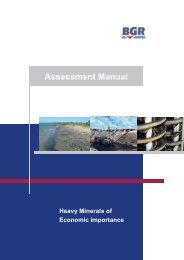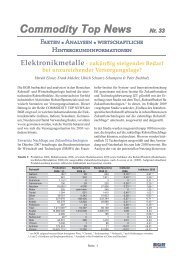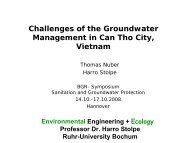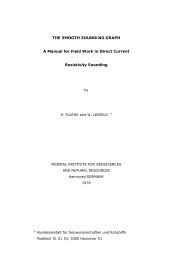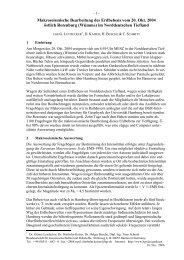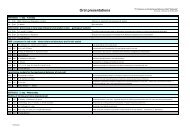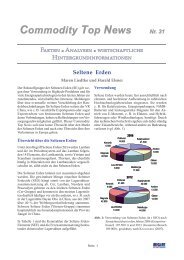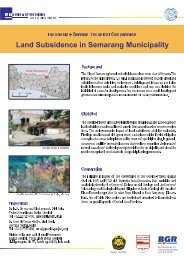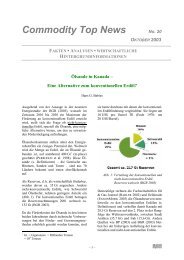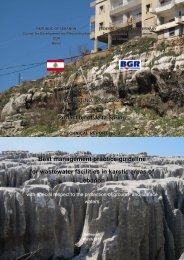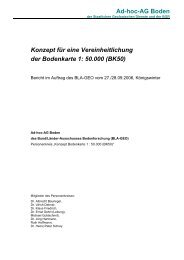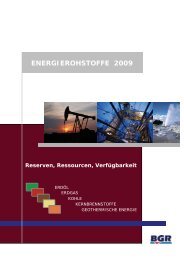GROUNDWATER AS PART OF THE WORK OF LAKE CHAD BASIN ...
GROUNDWATER AS PART OF THE WORK OF LAKE CHAD BASIN ...
GROUNDWATER AS PART OF THE WORK OF LAKE CHAD BASIN ...
You also want an ePaper? Increase the reach of your titles
YUMPU automatically turns print PDFs into web optimized ePapers that Google loves.
BACKGROUND<br />
<strong>GROUNDWATER</strong> <strong>AS</strong> <strong>PART</strong> <strong>OF</strong> <strong>THE</strong> <strong>WORK</strong><br />
<strong>OF</strong> <strong>LAKE</strong> <strong>CHAD</strong> B<strong>AS</strong>IN COMMISSION (LCBC)<br />
Presented by<br />
Engr. Muhammad Sani ADAMU<br />
Executive Secretary<br />
Lake Chad Basin Commission<br />
N’Djamena, Chad<br />
Situated in the eastern part of the Sahel region of Africa, at the southern edge<br />
of the Sahara desert, Lake Chad and its active basin constitutes an important<br />
freshwater resource shared by Cameroon, the Central African Republic, Chad,<br />
Niger and Nigeria. The surface area of the lake varies considerably with the<br />
amount of annual rainfall, and the recent historical variation in the surface area<br />
of the lake has ranged from approximately 25,000 to 2,000 km2. Lake Chad is<br />
Africa’s fourth largest lake (in terms of surface area) after Victoria, Tanganyika<br />
and Nyassa.<br />
Lake Chad is shallow – its average depth being 1.5 m – and is of relatively<br />
small volume. Two of Lake Chad’s tributaries, the Chari and Logone rivers,<br />
supply approximately 95% of the Lake’s surface water input. The lake is<br />
subject to considerable evaporation and yet is not saline. For thousands of<br />
years Lake Chad has been a centre of development, trading and cultural<br />
exchange between the people’s living to the north of the Sahara and those to<br />
the south. Today close to thirty million people depend for their livelihood on<br />
activities carried out in the lake and its active basin which includes important<br />
wetlands and floodplains covering 966,955 km2. The main economic activities<br />
of the people in the basin include fishing, farming, animal husbandry, mining<br />
and commerce.<br />
-
The geological and geo-morphological development of the basin has been<br />
conditioned by the slow and ‘’cool’’ rifting of the West and Central African Rift<br />
System which has formed a regional hydrological sink – the Lake Chad water<br />
body. The contributing sub-basins are underlain by basement complex in the<br />
supper source areas and by a progressively thick sequence of sedimentary<br />
deposits towards the lake.<br />
The hydro-stratigraphy in the sedimentary aquifers underlying the lake are only<br />
partially understood and the hydro-dynamic linkages to the Lake Chad water<br />
body are therefore conjectural. However, it is apparent that the close<br />
interaction between rainfall, evaporation, the generation of lateral inflow to the<br />
lake and the groundwater leakage under the body of the lake influence the<br />
overall lake balance. A distinction has to be made between hydrological and<br />
hydro-geological context of each influent tributary, and the aggregate water<br />
balance of Lake Chad itself. Equally there is a marked distinction between a<br />
humid period (prior to 1973) and the current drought regime that has persisted<br />
over the three decades.<br />
The significant feature of the hydrological context is the persistent change in<br />
the rainfall patterns over the basin as a whole. In the last 30 years isoheytal<br />
contours of mean rainfall have shifted to the south by an order of several<br />
hundred kilometers. The results of this shift are that areas that had<br />
experienced a mean rainfall of 320 mm (for example) now receive les than 210<br />
mm. in the hydrological active upstream basins, this large decrease in mean<br />
rainfall per annum has brought about a proportionally larger decrease in the<br />
basin yield, as river runoff, effluent groundwater flow, and flow thresholds are<br />
greatly reduced. This persistence in the rainfall regime is therefore resulting in<br />
a very attenuated basin yield and has to be set against burgeoning human<br />
demands upon the land and water resources of the system generally.<br />
-
For the realization of the socio-economic potentials of the Lake Chad Basin,<br />
four riparian States of the Lake Chad, namely Nigeria, Niger, Cameroon and<br />
Chad signed a Fort-Lamy (now N’Djamena) Convention on 22 nd May 1964<br />
formally creating a Lake Chad Commission with a broad mandate of drawing<br />
up, managing and implementing economic development projects, Integrated<br />
Water Resources Management conflict resolution among States, and<br />
promotion of regional integration, cooperation and security. In 1987 the<br />
Summit of the Heads of LCBC Member States (the highest decision-making<br />
body) decided to restructure LCBC. The restructuring programme was<br />
supported by UNDP and has been implemented since 1990. The resulting<br />
structure is a light organization that focuses on transboundary activities with<br />
emphasis on the integrated management of land, water and other natural<br />
resources of the Lake Chad Basin.<br />
At the time of is creation, the mandate of LCBC covered an area referred to as<br />
‘’Conventional Basin’’ of 427,300 sq.km, representing only about 18% of the<br />
hydrological basin. This conventional basin therefore excludes the largest<br />
desert expanses of Algeria, northern Niger, Libya and Sudan. In particular it<br />
also excluded the upstream part of the active basins of the Chari-Logone and<br />
Komadugu-Yobe River Systems.<br />
But with the adhesion of Central African Republic in 1994 as the 5 th member of<br />
LCBC, the Conventional Basin has been enlarged to include the upper basin<br />
of the main river systems of Chari-Logone-El Beid and Komadugu-Yobe<br />
covering a total of area of 966,955 sq.km. The Conventional Basin will further<br />
be enlarged with the adhesion of Libya in 2007 and the expected adhesion of<br />
Algeria and Sudan to Lake Chad Basin Commission.<br />
-
Current trends<br />
Climate change is regarded as the most important global change relevant to<br />
the Lake Chad Basin. In the past 30 years, the Sahel has experienced the<br />
most substantial and sustained decline in rainfall recorded anywhere in the<br />
world. Since 1971, the average of all stations fell below the 1989-year average<br />
and showed a persistent downward trend since 1951.<br />
A comparison of isohyets of the 1950s, which is regarded as the wettest<br />
decade, with the driest in the 1980s showed considerable shift towards the<br />
south (Olivry et al. 1996). In particular, the 400 mm isohyets moved 200-250<br />
km towards the south in the west of the Lake Chad, 100 km towards the south<br />
in the east but only few tens of kilometers in Ouaddai (Chad).<br />
The 1800 mm isohyets shifted by 300 km to the south at the longitude of<br />
Guera and by 200 km to the south east of Guera, in Nigeria. The reduction in<br />
rainfall was about 100 mm for each 100 km of distance apart from the annual<br />
and spatial variations (LCBC 2000b). The shift showed that areas that had<br />
experienced a mean rainfall of 320 mm (e.g. over the lake itself) received less<br />
than 210 mm (World Bank 2002b)<br />
The dramatic decrease in the surface area and volume of Lake Chad has been<br />
attributed to regional and global climate change as well as water management<br />
practices. Climate change thus remains a major determinant of the future of<br />
the lake’s volume and surface area. This is in addition to having serious<br />
implications for the availability of fresh water in the basin, resulting in<br />
competition, conflicts and migrations.<br />
Climate change has also impacted, and is still impacting on vegetation cover.<br />
There has been a general decline and disappearance of large trees and<br />
-
woody species with declining rainfalls, as well as the disappearance of<br />
perennials of the field layer. But the effects on vegetation did not exactly<br />
parallel the shifts of the isohyets, as soil types also had major effects in<br />
maintaining the status quo or in accelerating the rate of degradation, as do the<br />
effects of man and animals. Continuing degradation of the vegetation cover<br />
will have immediate direct implications for agriculture and livestock rearing.<br />
Already the north part of the hydrological basin is experiencing desertification<br />
at the rate of 2-3 km/annum southwards of the basin.<br />
Problems of the Lake Chad Basin<br />
The key attribute of the Lake Chad Basin is its importance as a source of fresh<br />
water for a population of about 30 million spread across six countries:<br />
Cameroon, CAR, Chad, Niger, Nigeria and Libya. Apart from the problems<br />
resulting from climate change, the major transboundary problems of these<br />
countries related to the interactions between water resources and their society<br />
in the Lake Chad Basin which are:<br />
1. Variability of hydrological regime and fresh water availability<br />
2. Decreased viability of biological resources<br />
3. Loss of biodiversity<br />
4. Loss and/or modification of ecosystems<br />
5. Sedimentation in rivers and water bodies<br />
6. Invasive species<br />
7. Other environmental degradation (soil erosion, pollution, etc.)<br />
8. Migration, refugees, farmers/transhumance conflicts.<br />
Other problems of the basin may be political (governance), economical and<br />
cultural which will not be discussed here. But the problem of managing the<br />
water resources is of course very important which needs to be highlighted<br />
-
here. Integrated water resources management in the Lake Chad, whether it is<br />
at national or regional level, has been very much hampered by the following<br />
facts which are still prevailing in the region:<br />
1. Bad management practices<br />
2. Poor decision-making<br />
3. Poor data management<br />
4. Absence or poor monitoring systems<br />
5. Absence or poor conservation policies and/or systems<br />
6. Lack of contingencies planning and resources mobilisation<br />
7. Lack of Focus on part of Managers<br />
8. Deficient legal framework (laws, regulations, guideline tariffs, etc)<br />
9. Weak coordination among sectors at national and regional levels<br />
10. Weak and persistent rural economy of Member States of LCBC<br />
11. Poor stakeholders’ participation.<br />
Therefore for Lake Chad Basin to achieve its common Vision 2025 where land,<br />
water and all natural resources are conserved, sustainably exploited, managed<br />
in an integrated manner and shared equitably, in order to ensure poverty<br />
eradication, improved living standard in peace and security, these<br />
predicaments must be overcomed. It therefore follows that LCBC now facing<br />
the following challenges:<br />
1. Environmental degradation<br />
2. Resources management<br />
3. Competition over access to diminishing resources<br />
4. Deep poverty of the populace.<br />
-
In order to overcome these challenges, the LCBC with the assistance from<br />
other stakeholders and development partners has mapped out the priority<br />
areas for action as follows:<br />
1. All stakeholders participation<br />
2. Development of IWRM at both national and Basin levels<br />
3. Capacity building involving all stakeholders<br />
4. Assessing and conservation of resources both on the surface and<br />
under the ground<br />
5. Recharging the Lake Chad and other wetlands in the Basin<br />
6. Poverty reduction<br />
7. Promotion of regional security and economic integration.<br />
FRAME<strong>WORK</strong> FOR ACTION<br />
Mobilization of political will and ensuring good governance is fundamental to<br />
the realization of the objectives of the vision. It is necessary to have a broad<br />
based support and commitment of all the basin’s stakeholders, donors and<br />
technical support agencies so that sacrifices and investments can be made to<br />
achieve the desired visions goals. This calls for dissemination of information<br />
particularly on the vision itself.<br />
It is in this spirit that the following actions are being done by all stakeholders at<br />
all levels including leaders of the riparian states<br />
1. Campaign to save Lake Chad Basin (launched since 1994)<br />
2. Engaging the Parliamentarians<br />
3. Engagement of political and traditional leaders of the Basin<br />
4. Establishment of Inter-Ministerial Committee (IMC) in the Member<br />
States<br />
-
5. Adoption of Vision, Master Plan, Strategic Action Plan and<br />
Programme<br />
6. Implementation of key projects.<br />
These key projects are geared towards the preparation of Strategic Action<br />
Programme, improving the knowledge management capacity of LCBC,<br />
recharging the basin wetlands (IBWT) as well as assessment of the<br />
underground water potentials in the Lake Chad Basin.<br />
For quite a long time since before the creation of the Lake Chad Basin<br />
Commission in 1964, groundwater all over the Lake Chad Basin has been<br />
exploited for water supply, animals’ consumption and to a lesser extent for<br />
industrial use. But there has never been an attempt to assess the quantity,<br />
quality and location of underground water, except recently when LCBC and<br />
some stakeholders started to think of the idea as an alternative to the<br />
diminishing surface water of the basin. So far LCBC has carried out few<br />
projects on underground water assessment since its inception. Notable studies<br />
carried out in the last four decades, includes:<br />
1. Survey of groundwater resources in the Lake Chad Basin which<br />
was carried out between May 1967 and 1972 with assistance from<br />
UNDP and FAO. It deals with the survey of groundwater conducted<br />
with a view to supplementing and, above all, extending present<br />
knowledge regarding the resources available in the Lake Chad Basin.<br />
The work done involved mainly the exploration of various known or<br />
assumed aquifers. It made possible, in particular:<br />
- to determine the limits of artesian activity and the extent of the<br />
lower Pliocene aquifer in Cameroon and Chad<br />
-
- to discover in these countries the existence of deeper artesian<br />
water resources, attributes to the terminal continental<br />
formation, and to evaluate the extent of this aquifer in the Chad<br />
Basin<br />
- to discover in Niger the existence of deep aquifer attributed to<br />
the Hamadian continental and intercalated continental<br />
formations respectively and to give a first assessment of their<br />
extent<br />
- to increase the data available leading to an improved<br />
knowledge of the general phreatic aquifer<br />
- to specify that chemical composition of the groundwater makes<br />
it unsuitable for irrigation, except possibly in the north of the<br />
Conventional Basin.<br />
Particular recommendations are given for each aquifer and for<br />
each country. They regard:<br />
- the establishment under the aegis of the LCBC of a network for<br />
observing fluctuations in and the dynamic properties of the<br />
phreatic aquifer;<br />
- the control of utilization of the limited resources of the lower<br />
pliocen aquifer;<br />
- the exploitation, in conjunction with the surveying of the<br />
terminal continental aquifer in Cameroon, Nigeria and Chad;<br />
- the utilization of the aquifers in the Hamadian continental and<br />
the intercalated continental formations.<br />
-
This project produces two main documents:<br />
- Hydro-geological study<br />
- Drilling investigations and data<br />
2. Monitoring and management of groundwater resources in the<br />
Lake Chad Basin<br />
This project was funded by the ‘’Fonds d’Aide et de Coopération de<br />
la Rération de la République Francaise’’ between 1991-1993. The<br />
studies were carried out by BGRM within the framework of the<br />
LCBC/M003/91 Contract, concluded between the Lake Chad Basin<br />
Commission and the BRGM.<br />
The aim of this project is to provide the Lake Chad Basin<br />
Commission (LCBC) with new tools for the management of<br />
groundwater resources, namely:<br />
- In the first stage ‘’the design and definition of a piezometric<br />
network, updating of data and implementation of an aquifer<br />
surveillance system’’ and the proposition of a system of<br />
quantitative and qualitative monitoring and control of<br />
groundwater in the Conventional Basin;<br />
- In the second stage ‘’Modeling of aquifer, resources evaluation<br />
and simulation of exploitation’’ with the characterization by a<br />
grid-numerical modeling of the two principal aquifer systems<br />
exploited in the basin. It results in the installation at LCBC<br />
Headquarters in N’Djamena of two models allowing the<br />
simulation of exploitation in each aquifer.<br />
-
As a conclusion this project reiterates the pressing need for<br />
rational management of groundwater resources in the Lake<br />
Chad Basin. It also recommended the controlling of artesian<br />
losses from the confined aquifers. Finally, brief mention was<br />
made of the various studies and installations dealing with<br />
groundwater resources which could be carried out in the future<br />
under the auspices of LCBC.<br />
3. Management of groundwater resources for the sustainable<br />
development of the Lake Chad Basin<br />
Within the framework of UNESCO/LCBC and with the BMZ financial<br />
support, this project was carried out between July 1997-December<br />
2007 with the objective to contribute to the better management and<br />
planning of water resources and to the development of manpower<br />
infrastructure and aimed at the establishment of a simulation model<br />
to characterize the upper aquifer behavior under three different<br />
climatic scenarios to facilitate groundwater resources management in<br />
the Lake Chad.<br />
Activities implemented<br />
Within the framework of the project and with the objective of<br />
improving the knowledge of the aquifer system, the following<br />
activities have been conducted:<br />
- An inventory of control points for piezometer head values (a<br />
piezometer is a borehole drilled to measure the fluctuating<br />
water level or ‘’head value’’ of groundwater) covering an area<br />
in both Chad and Cameroon, that was conducted in May of<br />
1998, during which 7 new boreholes were installed and 10 old<br />
-
ones were restored. These control points were also used for<br />
the determination of hydraulic and hydro chemical parameters;<br />
- Two surveys of head values using 374 control points: one<br />
piezometric survey was conducted at the end of the dry season<br />
(April – June 1998 and 1999) and the other at the end of the<br />
wet season (December – January 1998-1999 and 2000) to<br />
measure the difference in water levels between dry and wet<br />
seasons;<br />
- Two water samples collection campaigns for chemical<br />
analyses: one coinciding with the end of the dry season of<br />
1998, and another with the end of the wet season of 1998<br />
1999. Each campaign consisted of the collection of 100 water<br />
samples for chemical analyses, 75 for the determination of 18 O<br />
and Deuterium ( 2 H), and 58 samples for the determination of<br />
Tritium ( 3 H) contents;<br />
- The different hydrological units (Quaternary or ‘’upper aquifer’’)<br />
Lower Pliocene or ‘’intermediate aquifer’’ and Continental<br />
Terminal or ‘’Lower aquifer”) were spatially defined;<br />
- Hydraulic parameters (transmissivity characterizing the ability<br />
of am aquifer to drain water, storage coefficient characterizing<br />
the capacity of the aquifer to store water, etc.) were<br />
established from data obtained with pumping tests conducted<br />
within the framework of the project;<br />
- Hydrological modeling of the upper aquifer;<br />
- Simulations of the upper aquifer behavior were conducted<br />
under three different climatic scenarios (dry, medium, wet).<br />
-
Objectives achieved or to be achieved in the near future<br />
Within the framework of UNESCO/LCBC and with the BMZ<br />
financial support, the project ‘’Management of Groundwater<br />
Resources for the Sustainable Development of the Lake Chad<br />
Basin’’ has been carried out with the main following objectives:<br />
- Knowledge and quantification of water resources and recharge<br />
in the upper aquifer under three climatic scenarios (medium,<br />
dry and humid), as well as its suitability in terms of quality for<br />
various uses such as water supply and irrigation;<br />
- Evaluation of the aquifer recharge from floodplains and surface<br />
water;<br />
- Transfer of software for chemical analyses interpretation<br />
(AQUACHEM) as well as for hydro geological modeling<br />
(MODFLOW) to Maiduguri and Ngaoundere Universities.<br />
There are current negotiations for organizing an interregional<br />
workshop for the dissemination of results in the region at the<br />
Maiduguri University in Nigeria, one location of the UNESCO<br />
Virtual Laboratory on Drying Lakes.<br />
4. Sustainable Water Management Lake Chad - BGR Component<br />
This project is yet to kick start, but is a second phase to the on-going<br />
first phase project being carried out by the German Agency for<br />
Technical Cooperation (GTZ) on Sustainable Water Management<br />
Lake Chad aimed at developing a GIS based knowledge<br />
management system at the LCBC and formalizes data exchange<br />
between member countries and the LCBC.<br />
-
The overall goal of the two phases Project ‘’Sustainable Water<br />
Management Lake Chad’’ (GTZ and BGR) with a planned total<br />
implementation period of nine years is that the LCBC manages<br />
transboundary water resources sustainably. The goal of the second<br />
phase project – the BGR component (duration of three years) is:<br />
‘’The LCBC coordinates the exchange of information on groundwater<br />
resources with its member States and integrates this information into<br />
its knowledge management with the aim of developing a sustainable<br />
water resource strategy’’.<br />
The approach will rely to a large extent on capacity building. This will<br />
include training of national water resources experts of the member<br />
countries in collecting, processing and analyzing groundwater data.<br />
Within the LCBC a unit will be established and trained to regionally<br />
assess and analyze the combined national data and to feed<br />
information into the development of an integrated water resources<br />
strategy considering interaction with relevant other sectors.<br />
The implementation period of this project will start from the second<br />
half of 2007 up to mid 2010.<br />
Engr. Muhammad Sani ADAMU<br />
N’Djamena, 1 st July 2007<br />
-



